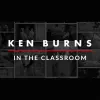Take a look inside 4 images
Ken Burns in the Classroom
Pros: Clips from Ken Burns' masterful documentaries combined with ready-to-use teaching materials.
Cons: Some of the premade lesson materials lack rigor.
Bottom Line: Top-notch documentary clips offer opportunities to expand students' perspectives, but some lesson materials might be underwhelming.
Teachers can preselect whole-class clips or allow student choice in perusing the options and focusing on an area of interest within a given era, topic, or film. For a quick and easy activity, look no further than the discussion questions offered alongside most clips. These can serve as primers before students watch something, as well as review discussions afterward. Students can also create and share their own essential questions based on their viewing.
For a more involved activity, teachers can use a media analysis framework. Task students with identifying a main idea, evidence or details, drawing, inquiry, and analysis of the film clip. Students can then share out on the class whiteboard prepared with each of the categories. In classrooms with 1-to-1 devices, groups of students can each focus on a different segment of a longer film (or individual group members can focus on individual segments). They can then answer discussion questions and/or use a 3-2-1 strategy to reflect on what they watched. Students within each group can have a discussion, and then teachers can facilitate a whole-class debriefing.
If classrooms use a lot of Ken Burns' work, why not encourage students to be their own digital storytellers? Students could create their own mini-documentaries or another creative showcase -- like a comic strip or book -- on a history topic of their choice. To up the ante, ask students to incorporate three methods of storytelling that they noticed Burns using, such as re-created narration or showing primary sources. This focuses students not only on high-quality research, but also on engaging delivery and presentation of the material.
Ken Burns in the Classroom is a free American history website offered by PBS LearningMedia. The site combines Ken Burns' critically acclaimed documentaries with ready-to-use teaching materials and lessons. Each documentary is available in precisely chunked and archived segments of one to nine minutes each. All of the clips can be searched by keyword, topic, era, or film. Clips include related videos, relevant teaching materials, and a Share to Google Classroom button.
For Ken Burns fans, a PBS sister site is linked at the bottom of the Ken Burns in the Classroom site, providing more research and access to more things Ken Burns.
The research and production of the film clips is unparalleled, but clever classroom activities will be needed to fully grab students' attention. However, the careful carving of the films into digestible (and easily browsed) pieces for students -- along with the printable handouts and premade lessons -- makes it incredibly easy to bring Ken Burns' work into classrooms. The activities, teaching tips, discussion questions, and handouts go beyond recall questions, but they vary in how well they encourage deep learning. In most cases, it's up to teachers to take it to next level, especially in, for instance, an AP-level class. Expect to do some further development of what's offered on the site. Teacher materials are also not scaffolded or differentiated, so expect to do some modification to fit your students' needs. Some films offer English subtitles to help with this.
One of the most useful aspects of Ken Burns in the Classroom is how well clips are organized. They're not just broken down by era or keyword; they're also organized thematically so that students can dig into concepts with or across eras. For example, the film The West is broken down into "Migration and Innovation," "Intercultural Encounters," and "Land-based Conflict." By orienting analysis according to these themes, teachers go beyond a timeline or key term approach to history, and focus more on analyzing change and continuity over time.












